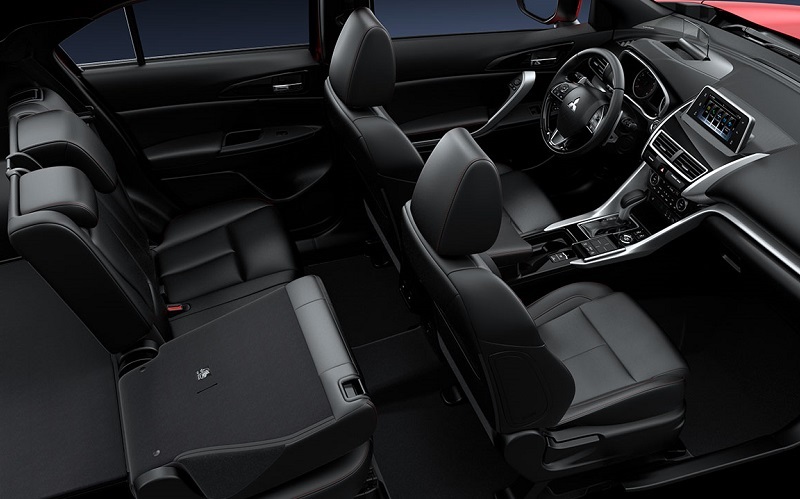The Mitsubishi Eclipse Cross is not quite up to snuff
Executive Wheels: While beautiful and well-equipped, this car doesn’t measure up
Jeff Rundles //February 4, 2020//


The Mitsubishi Eclipse Cross is not quite up to snuff
Executive Wheels: While beautiful and well-equipped, this car doesn’t measure up
Jeff Rundles //February 4, 2020//
2020 Mitsubishi Eclipse Cross SEL 1.5T S-AWC
Everywhere I went during my test-drive week, people stopped to ask me about the car I was driving, telling me how beautiful it was. And it’s fair, the Mitsubishi Eclipse Cross a handsome crossover/SUV in the small category, with distinctive styling that helps it stand out from the crowd. (And this one was painted Red Diamond, the finest red I’ve seen on a vehicle.)
However, beauty isn’t everything, I had concerns with the vehicle right off the bat. For one, when I heard from the press pool managers that I was getting a Mitsubishi Eclipse Cross I had no idea what it was because it is brand new model. Mitsubishi previously made an Eclipse sports coupe in the 1990s and my concern is that reusing names rarely works out.
Another main concern with this Eclipse Cross is its power: It has a 1.5-liter turbocharged 4-cylinder engine, but it is only rated at 152 horsepower and, frankly, it felt like less than that. The vehicle is very sluggish until you get up to speed like on the highway where it performs admirably. On the plus side, the mileage is great: 25 mpg city/26 mpg highway/25 combined. To be fair, many of these subcompact crossover/SUV models suffer from a power dearth. (For example, the Mazda CX-3 isn’t up to snuff with the rest of Mazda’s excellent CX line.)
While doing some research I came across an interesting article from Car and Driver magazine. Editors there decided to compare cargo space in subcompact Crossover/SUV by reclining all of the rear seats and seeing how many airline carry-on bags would fit in there. Oddly enough, the Mitsubishi Outlander was ranked best in class, holding 27 suitcases. The Eclipse Cross, on the other hand, came in dead last with a capacity of just 17 carry-on bags.
And this brings up another concern: Mitsubishi is down to just six vehicles, depending on how you look at it: the Outlander PHEV, the Outlander, the Outlander Spot, this Eclipse Cross and the sedans Mirage G4 and Mirage. The problem? The three Outlanders and the Eclipse Cross are all in the same category, with minor differences, which doesn’t make sense. To accentuate my point, the base price of the Outlander for 2020 is $24,895, the Outlander Sport $22,595, and this Eclipse Cross $22,995. You can load them up differently – different engine choices, for instance – but they are all pretty much the same vehicle.
Having said all of this, I actually very much enjoyed driving the Eclipse Cross for a week. But the truth is that I have driven many of the other vehicles in this class, and I can’t imagine a circumstance where I would choose the Eclipse. I would buy something else if I was looking in this marketplace.

But the Eclipse Cross, with all of these reservations, has some nice stuff. I drove the top-of-the-line trim offered, the SEL, and it was pretty loaded. It is stuffed with all the modern technology for both entertainment and safety that most of carmakers have today and then some special things. One of the coolest is the multi-view camera system that offers views out front, along the sides, rearview (of course), and one of those great bird’s eye views from above. Also, the S-AWD in the name of this vehicle means “Super All Wheel Control,” Mitsubishi’s AWD system that combines stability control, anti-lock brakes, all-wheel-drive and adds in Active Yaw Control that adds to handling control (the vehicle drives just fine in this respect).
Among the other cool things here were: a panoramic sunroof that was actually two sunroofs, one over the front seats and one over the back seat, and also, one of my favorite features that a few carmakers offer, a system that folds in the side mirrors when you lock the car.
As I mentioned, you can get an Eclipse Cross for $22,995 in front-wheel-drive, but this SEL, top-of-the-line of the four trims available, carries a base price of $28,595 with S-AWC. They added in a $2,100 Touring package – with the sunroof(s), upgraded sound system, forward collision mitigation, pedestrian detection, high-speed braking capability, adaptive cruise control, heated seats/steering wheel and roof rails – and they also charged $595 for that beautiful read paint, and a few hundred dollars for floor mats and covers. Add in a destination charge of $1.095 and the net cost here is $32,720.
That is a competitive price in the field for what is offered here, but I have my reservations. The bottom line? This is a very attractive subcompact crossover/SUV, with all the technology people expect these days, but overall, it’s not quite up to snuff.
RATING: 3 WHEELS (OUT OF FOUR)


























